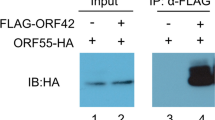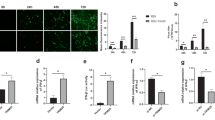Summary
Previously we showed for coxsackievirus A9 (CAV-9) that specific interactions between the RGD motif of capsid protein VP1 and the αvβ3 integrin are involved in virus binding and entry into green monkey kidney cells (GMK) and some other cell lines. The RGD-recognizing αvβ3 integrin is known as the vitronectin receptor (VNR). During replication in the gut, CAV-9 like all other enteroviruses are exposed to host proteolytic enzymes, and we showed previously that the RGD-containing 15 amino acids long carboxy terminal extension of VP1 is cleaved off by trypsin. The trypsin-treated CAV-9 was still infectious, although at an apparently reduced level as assessed in GMK cells. This indicated that the virus was able to bypass the RGD-dependent entry and possibly use an alternative receptor. We have now found that in RD cells, a human rhabdomyosarcoma cell line, neither RGD-containing oligopeptides nor polyclonal antiserum to VNR are able to protect the cells from CAV-9 infection suggesting that the RGD motif is not involved in binding or entry of the virus into these cells. This result was further confirmed by demonstrating that, in RD cells, the trypsin-treated CAV-9 lacking the RGD-containing insert appeared to be as infectious as the untreated virus. The most striking difference between the virus receptors in the RD and the GMK cells was seen when the rate of virus uncoating was studied. For virus particles bound to the RD cells, the uncoating step started already at 18–20 °C and the process went on rapidly at 36 °C resulting in complete disintegration of cell-bound virions. In contrast, αvβ3-bound virus particles in the GMK cells appeared to uncoat slowly even at 36 °C and during the 90 min observation period only a small, hardly visible fraction was found to be disintegrated. Trypsin-cleaved CAV-9 showed the rapid disintegration kinetics in GMK cells as well suggesting that these cells contain both types of receptor specificity. These results indicate that CAV-9 is able to use two different entry routes into host cells depending on the target cells and on phenotypic properties of the virus regulated by host proteases.
Similar content being viewed by others
References
Abraham G, Colonno RJ (1984) Many rhinovirus serotypes share the same cellular receptor. J Virol 51: 340–345
Bergelson JM, Shepley MP, Chan BMC, Hemler ME, Finberg RW (1992) Identification of the integrin VLA-2 as a receptor for echovirus 1. Science 255: 1718–1720
Bergelson JM, St. John N, Kawaguchi S, Chan M, Stubdal H, Modin J, Finberg RW, (1993) Infection by echovirus 1 and 8 depends on the α2 subunit of human VLA-2. J Virol 67: 6847–6852
Bergelson JM, Chan M, Solomon KR, St. John NF, Lin H, Finberg RW (1994) Decay-accelerating factor (CD 55), a glycosylphosphatidylinositol-anchored complement regulatory protein, is a receptor for several echoviruses. Proc Natl Acad Sci USA 91: 6245–6248
Berinstein A, Roivainen M, Hovi T, Mason PW, Baxt B (1995) Antibodies to the vitronectin receptor (integrin αvβ3) inhibit binding and infection of foot-and-mouth disease virus to cultured cells. J Virol 69: 2664–2666
Chang KH, Auvinen P, Hyypiä T, Stanway G (1989) The nucleotide sequence of coxsackievirus A9; implications for receptor binding and enterovirus classification. J Gen Virol 70: 3269–3280
Colonno R, (1987) Cell surface receptors for picornaviruses. Bio Essays 5: 1434–1437
Greve JM, Davis G, Meyer AM, Forte CP, Yost SC, Marlor CW, Kamarck ME McClelland A (1989) The major human rhinovirus receptor is ICAM-1. Cell 56: 839–847
Hofer F, Gruenberger M, Kowalski H, Machat H, Huetinger M, Kuechler E, Blaas D (1994) Members of the low density lipoprotein receptor family mediate cell entry of a minor-group common cold virus. Proc Natl Acad Sci USA 91: 1839–1842
Hughes PI, Horsnell C, Stanway G (1995) The coxsackievirus A9 RGD motif is not essential for virus viability. J Virol 69: 8035–8040
Hyypiä T, Kallajoki M, Maaronen M, Stanway G, Kandolf R, Auvinen P, Kalimo H (1993) Pathogenetic differences between coxsackie A and B virus infections in newborn mice. Virus Res 27: 71–78
Kronenberger P, Vrijsen R, Boeyé A (1992) Compartmentalization of subviral particles during poliovirus eclipse in HeLa cells. J Gen Virol 73: 1739–1744
Marsh M, Helenius A (1989) Virus entry into animal cells. Adv Virus Res 36: 107–151
Mendelsohn CE, Wimmer E, Racaniello VR (1989) Cellular receptor for poliovirus: molecular cloning, nucleotide sequence, and expression of a new member of the immunoglobulin superfamily. Cell 56: 855–865
Piirainen L, Airaksinen A, Hovi T, Roivainen M (1996) Selective cleavage by trypsin of the capsid protein VP1 of type 3 poliovirus results in improved sorting of cell bound virions. Arch Virol 141: 1011–1020
Pulli T, Koshimies P, Hyypiä T (1995) Molecular comparison of coxsackie A virus serotypes. Virology 212: 30–38
Raab de Verdugo U, Selinka HC, Huber M, Kramer B, Kellermann J, Hofschneider PH, Kandolf R (1995) Characterization of a 100-kilodalton binding protein for the six serotypes of coxsackie B viruses. J Virol 69: 6751–6757
Roivainen M, Hyypiä T, Piirainen L, Kalkkinen N, Stanway G, Hovi T (1991) RGD-dependent entry of coxsackievirus A9 into host cells and its bypass after cleavage of VP1 protein by intestinal proteases. J Virol 65: 4735–4740
Roivainen M, Piirainen L, Hovi T, Virtanen I, Riikonen T, Heino J, Hyypiä T (1994) Entry of coxsackievirus A9 into host cells: specific interactions with αvβ3 integrin, the vitronectin receptor. Virology 203: 357–365
Ward T, Pipkin PA, Clarkson NA, Stone DM, Minor PD, Almond J (1994) Decay-accelerating factor CD55 is identified as the receptor for echovirus 7 using CELICS, a rapid immuno-focal cloning method. EMBO J 13: 5070–5074
Author information
Authors and Affiliations
Rights and permissions
About this article
Cite this article
Roivainen, M., Piirainen, L. & Hovi, T. Efficient RGD-independent entry process of coxsackievirus A9. Archives of Virology 141, 1909–1919 (1996). https://doi.org/10.1007/BF01718203
Received:
Accepted:
Issue Date:
DOI: https://doi.org/10.1007/BF01718203




